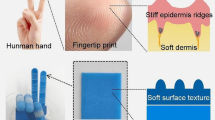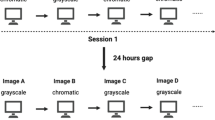Abstract
In this paper, we present a tactile rendering algorithm applied to an electrostatic tactile display that adjusts three parameters of the driving signal (amplitude, frequency, and waveform) to modulate the tangential friction force between a user’s finger and a touch screen. The aim of this work is to find an effective electrostatic tactile rendering algorithm to improve the tactile perception of image textures. The key idea is to jointly adjust the three parameters of the driving signal to increase the perceptual difference interval between image textures. We first explore the tactile representation characteristics of amplitude, frequency and waveform through subjective perception experiments. Based on these characteristics, we establish tactile mapping models between the three parameters of the driving signal and image textures. Finally, we use subjective evaluation experiments to verify the effectiveness of the proposed rendering method. The results show that the proposed rendering method can achieve a better tactile experience compared with rendering methods that realize tactile representation by only varying amplitude.















Similar content being viewed by others
References
Kaboli, M., Yao, K., Feng, D., Cheng, G.: Tactile-based active object discrimination and target object search in an unknown workspace. Auton. Robots 43(1), 123–152 (2019)
Meyer, D.J., Wiertlewski, M., Peshkin, M.A., Colgate, J.E.: Dynamics of ultrasonic and electrostatic friction modulation for rendering texture on haptic surfaces. In: Haptics Symposium (HAPTICS), 2014 IEEE, pp. 63–67 (2014)
Wiertlewski, M., Lozada, J., Hayward, V.: The spatial spectrum of tangential skin displacement can encode tactual texture. IEEE Trans. Robot. 27(3), 461–472 (2011)
Yatani, K., Truong, K.N.: SemFeel: a user interface with semantic tactile feedback for mobile touch-screen devices. In: Proceedings of the 22nd Annual ACM Symposium on User Interface Software and Technology, pp. 111–120 (2009)
Yang, G.H., Jin, M., Jin, Y., Kang, S.: T-mobile: vibrotactile display pad with spatial and directional information for hand-held device. In: 2010 IEEE/RSJ International Conference on Intelligent Robots and Systems, pp. 5245–5250 (2010)
Koo, I.M., Jung, K., Koo, J.C., Nam, J.D., Lee, Y.K., Ryeol, H.: Development of soft-actuator-based wearable tactile display. IEEE Trans. Robot. 24(3), 549–558 (2008)
Biet, M., Giraud, F., Lemaire-Semail, B.: Squeeze film effect for the design of an ultrasonic tactile plate. IEEE Trans. Ultrason. Ferroelectr. Freq. Control 54(12), 2678–2688 (2008)
Amberg, M., Giraud, F., Semail, B., Olivo, P., Casiez, G., Roussel, N.: STIMTAC: a tactile input device with programmable frictio. In: Proceedings of the 24th Annual ACM Symposium Adjunct on User Interface Software and Technology, pp. 7–8 (2011)
Yamamoto, A., Ishii, T., Higuchi, T.: Electrostatic tactile display for presenting surface roughness sensation. In: IEEE International Conference on Industrial Technology, pp. 680–684 (2003)
Kim, S.C., Israr, A., Poupyrev, I.: Tactile rendering of 3D features on touch surfaces. In: Proceedings of the 26th Annual ACM Symposium on User Interface Software and Technology, pp. 531–538 (2013)
Campbell, P.: Editorial on special issue on big data: community cleverness required. Nature 455(7209), 1–1 (2008)
Yan, X., Li, R., Sun, X., Liu, G.: Effects of touch force profiles and waveforms of electrostatic tactile feedback on touchscreen pan operation. Comput. J. 62(7), 1016–1035 (2018)
Martínez, J., García, A.S., Molina, J.P., et al.: An empirical evaluation of different haptic feedback for shape and texture recognition. Vis. Comput. 29(2), 111–121 (2013)
Prescher, D., Bornschein, J., Köhlmann, W., Weber, G.: Touching graphical applications: bimanual tactile interaction on the HyperBraille pin-matrix display. Univ. Access Inf. Soc. 17(2), 391–409 (2018)
Liu, G., Sun, X., Wang, D., et al.: Effect of electrostatic tactile feedback on accuracy and efficiency of pan gestures on touch screens. IEEE Trans. Haptics 11(1), 51–60 (2017)
Miao, Y., Jiang, Y., Peng, L., et al.: Telesurgery robot based on 5G tactile Internet. Mobile Netw. Appl. 23(6), 1645–1654 (2018)
Xia, P., Lopes, A.M., Restivo, M.T.: Virtual reality and haptics for dental surgery: a personal review. Vis. Comput. 29(5), 433–447 (2013)
Mallinckrodt, E., Hughes, A.L., Sleator, W.: Perception by the skin of electrically induced vibrations. Science 118(3062), 277–278 (1953)
Strong, R.M., Troxel, D.E.: An electrotactile display. IEEE Trans. Man Mach. Syst. 11(1), 72–79 (1970)
Robles-De-La-Torre, G., Hayward, V.: Force can overcome object geometry in the perception of shape through active touch. Nature 412(6845), 445–448 (2001)
Bau, O., Poupyrev, I., Israr, A., Harrison, C.: TeslaTouch: electrovibration for touch surfaces. In: Proceedings of UIST 10. ACM, pp. 283–292 (2010)
Linjama, J., Mäkinen, V.: E-sense screen: novel haptic display with capacitive electrosensory interface. In: HAID 2009, 4th workshop for haptic and audio interaction design (2009)
Yamamoto, A., Nagasawa, S., Yamamoto, H., Higuchi, T.: Electrostatic tactile display with thin film slider and its application to the tactile telepresentation systems. IEEE Trans. Vis. Comput. Graph. 12(2), 168–177 (2006)
Xu, C., Israr, A., Poupyrev, I., et al.: Tactile display for the visually impaired using TeslaTouch. In: CHI11 extended abstracts on human factors in computing systems, pp. 317–322 (2011)
Minsky, M., Ming, O., Steele, O., Brooks Jr., F.P., Behensky, M.: Feeling and seeing: issues in force display. ACM SIGGRAPH Comput. Graph. 24(2), 235–241 (1990)
Wang, T., Sun, X., et al.: Electrostatic tactile rendering of image based on shape from shading. In: Audio, Language and Image Processing (ICALIP), 2014 International Conference on IEEE, pp. 775–779 (2014)
Wu, S., Sun, X., Wang, Q., Chen, J.: Tactile modeling and rendering image-textures based on electrovibration. Vis. Comput. 33(5), 637–646 (2017)
Saga, S., Deguchi, K.: Lateral-force-based 2.5-dimensional tactile display for touch screen. In: Haptics Symposium (HAPTICS), 2012 IEEE, pp. 15–22 (2012)
Osgouei, R.H., Kim, J.R., Choi, S.: Improving 3D shape recognition with electrostatic friction display. IEEE Trans. Haptics 10(4), 533–544 (2017)
Kim, J.R., Shin, S.: Touch3D: touchscreen interaction on multiscopic 3D with electrovibration haptics. In: ACM SIGGRAPH 2017 Posters, pp. 1–2 (2017)
Kim, S.C., Han, B.K., Kwon, D.S.: Haptic rendering of 3D geometry on 2D touch surface based on mechanical rotation. IEEE Trans. Haptics 11(1), 140–145 (2018)
Vasudevan, H., Manivannan, M.: Recordable haptic textures. In: 2006 IEEE International Workshop on Haptic Audio Visual Environments and their Applications, pp. 130–133 (2006)
Culbertson, H., Kuchenbecker, K.J.: Importance of matching physical friction, hardness, and texture in creating realistic haptic virtual surfaces. IEEE Trans. Haptics 10(1), 63–74 (2017)
Sianov, A., Harders, M.: Exploring feature-based learning for data-driven haptic rendering. IEEE Trans. Haptics 11(3), 388–399 (2018)
Ilkhani, G., Aziziaghdam, M., Samur, E.: Data-driven texture rendering with electrostatic attraction. In: International Conference on Human Haptic Sensing and Touch Enabled Computer Applications. Springer, Berlin, pp. 496–504 (2014)
Osgouei, R.H., Shin, S., Kim, J.R., et al.: An inverse neural network model for data-driven texture rendering on electrovibration display. In: Haptics Symposium (HAPTICS), 2018 IEEE, pp. 270–277 (2018)
Jiao, J., Zhang, Y., Wang, D., Visell, Y., Cao, D., Guo, X., Sun, X.: Data-driven rendering of fabric textures on electrostatic tactile displays. In: Haptics Symposium (HAPTICS), 2018 IEEE, pp. 169–174 (2018)
Hwang, I., Seo, J., Kim, M., Choi, S.: Vibrotactile perceived intensity for mobile devices as a function of direction, amplitude, and frequency. IEEE Trans. Haptics 6(3), 352–362 (2013)
Okamoto, S., Nagano, H., Yamada, Y.: Psychophysical dimensions of tactile perception of textures. IEEE Trans. Haptics 6(1), 81–93 (2013)
Levitt, H.: Transformed up-down methods in psychoacoustics. J. Acoust. Soc. Am. 49(2B), 467–477 (1971)
Acknowledgements
This work was partially supported by the National Natural Science Foundation of China (61631010).
Author information
Authors and Affiliations
Corresponding author
Ethics declarations
Conflict of interest
The authors, Xuezhi Yan, Qiushuang Wu, Guohong Liu, and Xiaoying Sun, declare that they have no conflict of interest.
Additional information
Publisher's Note
Springer Nature remains neutral with regard to jurisdictional claims in published maps and institutional affiliations.
Rights and permissions
About this article
Cite this article
Yan, X., Wu, Q., Liu, G. et al. Improving the tactile perception of image textures based on adjustable amplitude, frequency, and waveform. Vis Comput 37, 1297–1308 (2021). https://doi.org/10.1007/s00371-020-01866-w
Published:
Issue Date:
DOI: https://doi.org/10.1007/s00371-020-01866-w




